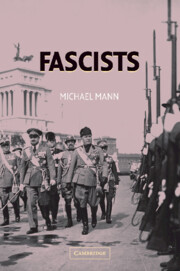Book contents
- Frontmatter
- Contents
- Preface
- 1 A Sociology of Fascist Movements
- 2 Explaining the Rise of Interwar Authoritarianism and Fascism
- 3 Italy: Pristine Fascists
- 4 Nazis
- 5 German Sympathizers
- 6 Austro-Fascists, Austrian Nazis
- 7 The Hungarian Family of Authoritarians
- 8 The Romanian Family of Authoritarians
- 9 The Spanish Family of Authoritarians
- 10 Conclusion: Fascists, Dead and Alive
- Appendix
- Notes
- Bibliography
- Index
8 - The Romanian Family of Authoritarians
Published online by Cambridge University Press: 05 June 2012
- Frontmatter
- Contents
- Preface
- 1 A Sociology of Fascist Movements
- 2 Explaining the Rise of Interwar Authoritarianism and Fascism
- 3 Italy: Pristine Fascists
- 4 Nazis
- 5 German Sympathizers
- 6 Austro-Fascists, Austrian Nazis
- 7 The Hungarian Family of Authoritarians
- 8 The Romanian Family of Authoritarians
- 9 The Spanish Family of Authoritarians
- 10 Conclusion: Fascists, Dead and Alive
- Appendix
- Notes
- Bibliography
- Index
Summary
INTRODUCTION: BACKGROUND
I delineated the overall contours of Romanian fascism in my introduction to the previous chapter. Here I introduce Romania the country, the most economically backward and the politically newest country I analyze in this book. Modern Romania had emerged only in 1861 as a union between Moldavia and Wallachia (itself composed of the provinces of Oltenia and Muntenia), just wrested from the retreating Ottoman Empire. World War I then brought an extraordinary bonanza to this small country, as can be seen in Map 8.1.
Tempted by territorial bribes from the Entente, Romania had declared war on the Central Powers in 1915. The payoff in the Peace Treaties was immense: the province of Bukovina gained from Austria, Transylvania and parts of the Crisana-Banat from Hungary, Bessarabia from Russia, and Dobruja from Bulgaria. This more than doubled Romania's territories and population, while non-Romanians rose to 30 percent of total population (despite large-scale emigration of minorities back to their “homelands”). Ethnicity was now more politically relevant and more entwined with class, since the lower and rural classes of the new territories tended to be Romanian, while the upper and urban classes were mostly drawn from formerly ruling nationalities (especially Magyars and Germans) plus Jews. Non-Romanians – mainly Jews, Hungarians, and Germans – owned the majority of manufacturing and commercial enterprises, and a large majority of the bigger ones.
- Type
- Chapter
- Information
- Fascists , pp. 261 - 296Publisher: Cambridge University PressPrint publication year: 2004



